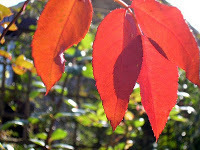Lindsay Townsend's Blog, page 26
March 10, 2011
'Night of the Storm' available again
 My 1996 Hodder title, Night of the Storm, has been out of print for a while, but no longer. I've uploaded it to Smashwords and it's yours for $1.99 in all the usual formats. Just visit my profile here and off you go.
My 1996 Hodder title, Night of the Storm, has been out of print for a while, but no longer. I've uploaded it to Smashwords and it's yours for $1.99 in all the usual formats. Just visit my profile here and off you go. Readers of A Secret Treasure will recognise the Rhodes setting, though this book blends suspense, romance and the wildlife smuggling trade.
Published on March 10, 2011 22:18
March 1, 2011
'The earth glows again with flowers': a medieval spring
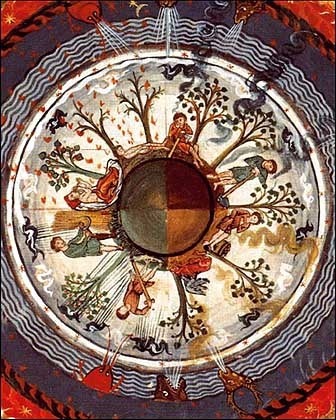 Spring was a longed-for season in the middle ages. After the dark and cold of winter, the lengthening days, the increasing warmth of the sun, the first showing of fresh green growth and flowers, were all savoured. Spring was the time when Easter took place, one of the most important religious festivals in medieval times and also a celebration of new life and feasting after the long fasting of Lent.
Spring was a longed-for season in the middle ages. After the dark and cold of winter, the lengthening days, the increasing warmth of the sun, the first showing of fresh green growth and flowers, were all savoured. Spring was the time when Easter took place, one of the most important religious festivals in medieval times and also a celebration of new life and feasting after the long fasting of Lent.Spring was when many plants were gathered to make dyes for clothes, to transform gowns and robes. New leaves, lichens, flowers and mosses were all gathered.
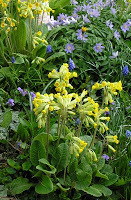 People would go walking in the woodland and meadows, relishing the time outdoors. Primroses, used to decorate church altars in May to honour the Virgin Mary, were seen as the first flowers of spring. Later in spring, cowslips were gathered an made into balls by young women, keen to forecast the name of their future husbands by tossing the cowslip ball among each other while calling out men's names. When the ball fell at the feet of a girl, that could be a sign that Martha could be marrying a Tom later - and so on.
People would go walking in the woodland and meadows, relishing the time outdoors. Primroses, used to decorate church altars in May to honour the Virgin Mary, were seen as the first flowers of spring. Later in spring, cowslips were gathered an made into balls by young women, keen to forecast the name of their future husbands by tossing the cowslip ball among each other while calling out men's names. When the ball fell at the feet of a girl, that could be a sign that Martha could be marrying a Tom later - and so on.Spring flowers were also used to flavour ale or wine or food - wild garlic could be used to make garlic sauce to add variety to the very bland diet of pottages. Herbs such as rosemary were made into posies, believed to help combat the plague. Daisies, prized for their whiteness, were also used in posies.
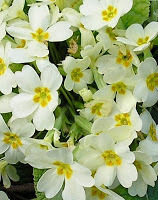 To rid themselves of worms and other internal parasites, medieval people gathered spurge, and to supplement their sometimes meager diets men and women would gather young salad leaves from the hedgerows, such as salad burnet, sorrel, hawthorn shoots, wild radish, mint and more.
To rid themselves of worms and other internal parasites, medieval people gathered spurge, and to supplement their sometimes meager diets men and women would gather young salad leaves from the hedgerows, such as salad burnet, sorrel, hawthorn shoots, wild radish, mint and more.Spring was seen as a joyous season, much celebrated in poetry (my title comes from the same manuscript as the Carmina Burana), but I'll leave that for another time.
Published on March 01, 2011 11:26
February 16, 2011
A real medieval woman
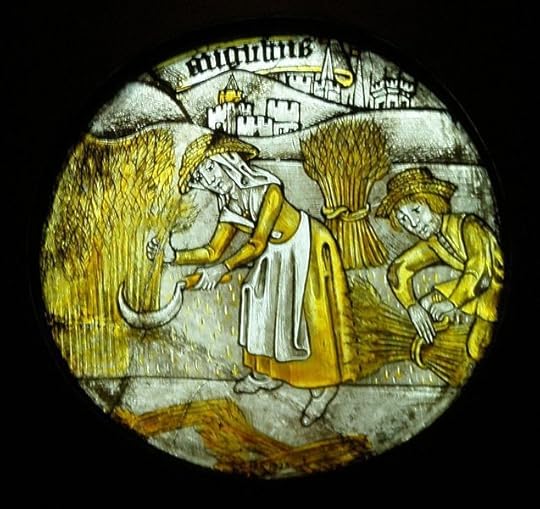 I read a lot of books of social history, naturally enough. I'm reading one now about the life of a medieval woman, Cecilia Penifader: A Medieval Life: Cecilia Penifader of Brigstock, c. 1297-1344
I read a lot of books of social history, naturally enough. I'm reading one now about the life of a medieval woman, Cecilia Penifader: A Medieval Life: Cecilia Penifader of Brigstock, c. 1297-1344 , by Judith Bennett.
, by Judith Bennett.This is a fascinating account of one of the lesser-known groups in the middle ages - a peasant, and moreover a peasant woman. Of all the groups in medieval society, the peasants - 'those who work' - are the least known to us via their own words, because few were literate. Detailed lives such as this one redress the balance and take us into a distant, living past, drawn from court and manorial documents.
Cecilia, we learn, was sometimes known as Cissa. Isn't that lovely! I find the centuries drop away at that intimate detail.
She had three brothers and four sisters. She never married, survived the great famine of the early 1300s, sometimes stole from her neighbours and lived in Brigstock, a village in Oxfordshire, all her life. Through her we learn about daily life, the church year, the work of the seasons, and more.
I've written about a day in the life of a medieval peasant woman today for Unusual Historicals. Please read it here.
Published on February 16, 2011 13:13
February 11, 2011
This weekend I'm taking part in a Valentine's Party

This weekend I'm taking part in a Valentine's Party at The Long and the Short of It Blog http://lasrguest.blogspot.com/ and the Goddess Fish Promotions Blog http://goddessfishparty.blogspot.com/. Please come see - there are lots of authors taking part and it should be fun.
Published on February 11, 2011 21:04
February 2, 2011
'To Touch The Knight' available as a pre-order
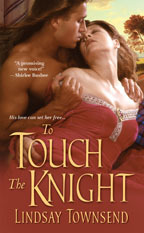 My next Kensington medieval romance is due out in July and available now for pre-order.
To Touch the Knight
is set during the time of the Black Death, when almost a third of the people in Britain died due to the plague. It was a period of massive change and terror, but also, for the survivors, a chance for a better life. You can find more, including an excerpt and buy links, here.
My next Kensington medieval romance is due out in July and available now for pre-order.
To Touch the Knight
is set during the time of the Black Death, when almost a third of the people in Britain died due to the plague. It was a period of massive change and terror, but also, for the survivors, a chance for a better life. You can find more, including an excerpt and buy links, here.
Published on February 02, 2011 08:39
December 30, 2010
December 19, 2010
Medieval people and their pets
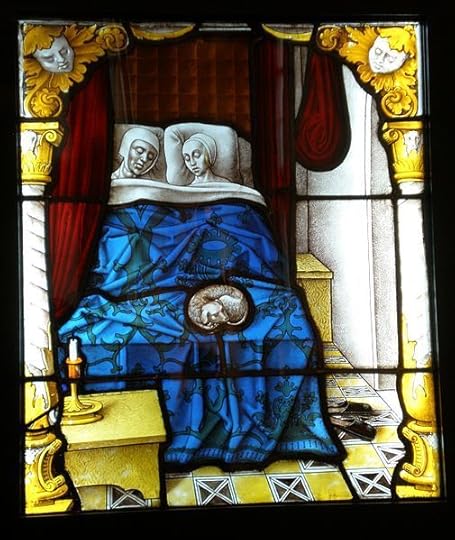 In the Middle Ages women and men often doted on their pets. In York Minster, there is a portrait of the lap dog of Lady Margaret Roos, rendered in stained glass. The dog looks happy and sleek, with a belled collar. In the picture here of Tobias and Sara, a window of about 1520 from Cologne, the couple's pet dog is a sleepy symbol of wedded tranquillity.
In the Middle Ages women and men often doted on their pets. In York Minster, there is a portrait of the lap dog of Lady Margaret Roos, rendered in stained glass. The dog looks happy and sleek, with a belled collar. In the picture here of Tobias and Sara, a window of about 1520 from Cologne, the couple's pet dog is a sleepy symbol of wedded tranquillity. In other drawings of medieval pets, the British Library has a manuscript showing a woman with a pet squirrel while the Luttrell Psalter shows a collared pet squirrel as a sign of status.
Birds were also popular. Jays and magpies - called 'pies' - were kept in cages and taught to copy speech. Larks and nightingales were kept for their sweet songs.
 Cats in the Middle Ages were kept mainly as mousers, and also, more grimly, for their fur and skins. Yet cats were also treasured. Exeter Cathedral lists in its accounts from 1305 to 1467 the sum of a penny a week to feed the cathedral cats if the animals did not catch many mice in the main church.
Cats in the Middle Ages were kept mainly as mousers, and also, more grimly, for their fur and skins. Yet cats were also treasured. Exeter Cathedral lists in its accounts from 1305 to 1467 the sum of a penny a week to feed the cathedral cats if the animals did not catch many mice in the main church. Dogs remained a favourite - so much so that nunneries tried and failed to ban the keeping of dogs as pets in various convents. Nuns were warned not to bring their pets into church and the pets included dogs, hunting dogs, rabbits, squirrels, birds and even monkeys.
Hunting dogs and hawks were not officially pets, being used to hunt and bring extra food for the table and to provide sport and entertainment to their lords and ladies. However, hawks were also massive status symbols, given as kingly gifts and well-known as signs of wealth and power. As such they were pampered and displayed - so much so that perches were even brought indoors to their owners could have their falcons with them. In 1368 the Abbot of Westminster, Nicholas de Litlington, bought a wax image of a falcon to offer at the altar to help a sick falcon recover. Lay men and women often brought their pets into church - the men with hawks on their wrists and women with lap-dogs.
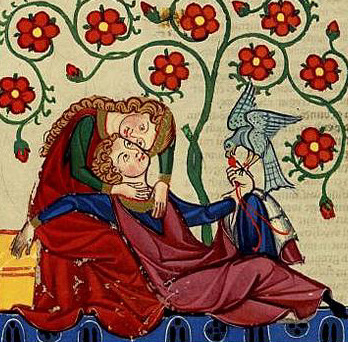 Breeds of pets changed over time and some are unknown to us now. Medieval man in particular had a passion for hunting and bred horses and dogs for that activity. There were horses bred for stamina and long chases through woodland after quarry, sturdy beasts called coursers (chasers) And as a hunting dog, the big, deep-chested, long-legged alaunt was much prized.
Breeds of pets changed over time and some are unknown to us now. Medieval man in particular had a passion for hunting and bred horses and dogs for that activity. There were horses bred for stamina and long chases through woodland after quarry, sturdy beasts called coursers (chasers) And as a hunting dog, the big, deep-chested, long-legged alaunt was much prized. The alaunt makes an appearance in my third knight book, A Knight's Enchantment. You can read an excerpt here.
Published on December 19, 2010 19:27
December 3, 2010
An early Christmas present? 'Flavia's Secret' free at Bookstrand
 Bookstrand have Flavia's Secret on offer as a free ebook from today until Valentine's Day. If you haven't tried one of my books yet, here's a chance!
Bookstrand have Flavia's Secret on offer as a free ebook from today until Valentine's Day. If you haven't tried one of my books yet, here's a chance!For details of the book and the free download, go to:
http://www.bookstrand.com/flavias-secret .
Published on December 03, 2010 14:25
November 18, 2010
A Christmas Sleeping Beauty
[image error]
Heaving his battle axe with practised skill, Prince Orlando hacked a path through the final thicket of thorns and stepped through into the princess' bedchamber. His shoulders and back ached and his jerkin was ripped, his leggings muddy and pierced by rose thorns, but he grinned widely.
"I have done what no other prince could do. I have won through!" He smacked his lips, anticipating the envy of his friends and praise of his parents. Shaking cobwebs from his bright blond hair, he strode forward, confident in the strength of his twenty-four years, his good looks and his weapons.
What if this "beauty" is ugly? he thought, as he dropped off his pack and approached the great four poster bed in the middle of the dim, wood panelled room, not troubling to be quiet. He shrugged as he drew back the bed hanging - he could leave her to sleep for another hundred years for some other less exacting ruler, a duke perhaps.
He gasped and sank to his knees, dragging part of the heavy coverlet with him. The girl curled on her side, fast asleep, in the middle of the twilight-blue silken sheets, was glorious, fit for any prince, even him. She was small, with long, glossy black hair, a lithe, flawless figure and the most perfect pink little mouth. Lips sweeter than sugar cane, he wagered, congratulating himself again.
He rolled her onto her back and straightened out her slim, taut limbs. She did not stir. Her breath was sweeter than peppermint and her skin was like ivory, tinted faintly with rose. The room was gloomy, without windows or torches, but she glowed like a pearl, as if lit from within. Her nightdress was white and trimmed with lace, the kind of old-fashioned gown his grandmother used to wear. He imagined himself ripping it from her, plundering those lush pink lips for kiss after kiss as she gasped her thankfulness and gratitude and he made her his, right here in the great bed. And after that, of course, the kingdom would be his, for her parents would make him their heir.
A swift marriage in the cathedral before Christmas and all would be well. He would hire tutors for her, to teach her the modern ways, but if she was as soft and obedient as his grandmother had been, then all would be very well indeed.
And I am going to marry her, he thought.
He tugged off his boots and sank onto the bed. He would kiss her forehead first and then her mouth, he decided. He caught her wrists in one of his large hands, so she would not scratch him when she woke.
Her flesh was warm and fragrant. A small pulse thudded in her temple as she responded to him. The weariness of his long hunt for this fabled kingdom dropped away as he knelt on top of her, careful not to crush her with his weight, and lowered his head.
A snap behind him had him sprawling off her, knife ready, shielding his prize.
He relaxed, realizing a log in the fireplace had fallen, and turned back.
"None shall take her from you, eh, prince?"
A woman appeared beside the carefully laid fire. She was nearly as tall as him, with iron-gray hair and a handsome, if sharp face. She was robed in the latest fashion and carried a sheath of yellow iris which she proceeded to arrange into a tall blue vase beside the bed. "I suppose you tried to defend her, at least."
Orlando fingered his knife. "Who are you, woman?"
"There." She gave the flowers a final shake. "These are some of her favorites. Have you brought flowers?"
"What for?"
"For the princess!" She gave him an expression he had last seen on the harassed face of his Latin tutor. "Do you expect to woo her with nothing?"
Prince Orlando felt things had gone far enough. He lifted the sleeping young woman into his arms and kissed her firmly on the lips.
Her head fell back a little but she slept on.
You can read the rest of this story here .

"I have done what no other prince could do. I have won through!" He smacked his lips, anticipating the envy of his friends and praise of his parents. Shaking cobwebs from his bright blond hair, he strode forward, confident in the strength of his twenty-four years, his good looks and his weapons.
What if this "beauty" is ugly? he thought, as he dropped off his pack and approached the great four poster bed in the middle of the dim, wood panelled room, not troubling to be quiet. He shrugged as he drew back the bed hanging - he could leave her to sleep for another hundred years for some other less exacting ruler, a duke perhaps.
He gasped and sank to his knees, dragging part of the heavy coverlet with him. The girl curled on her side, fast asleep, in the middle of the twilight-blue silken sheets, was glorious, fit for any prince, even him. She was small, with long, glossy black hair, a lithe, flawless figure and the most perfect pink little mouth. Lips sweeter than sugar cane, he wagered, congratulating himself again.
He rolled her onto her back and straightened out her slim, taut limbs. She did not stir. Her breath was sweeter than peppermint and her skin was like ivory, tinted faintly with rose. The room was gloomy, without windows or torches, but she glowed like a pearl, as if lit from within. Her nightdress was white and trimmed with lace, the kind of old-fashioned gown his grandmother used to wear. He imagined himself ripping it from her, plundering those lush pink lips for kiss after kiss as she gasped her thankfulness and gratitude and he made her his, right here in the great bed. And after that, of course, the kingdom would be his, for her parents would make him their heir.
A swift marriage in the cathedral before Christmas and all would be well. He would hire tutors for her, to teach her the modern ways, but if she was as soft and obedient as his grandmother had been, then all would be very well indeed.
And I am going to marry her, he thought.
He tugged off his boots and sank onto the bed. He would kiss her forehead first and then her mouth, he decided. He caught her wrists in one of his large hands, so she would not scratch him when she woke.
Her flesh was warm and fragrant. A small pulse thudded in her temple as she responded to him. The weariness of his long hunt for this fabled kingdom dropped away as he knelt on top of her, careful not to crush her with his weight, and lowered his head.
A snap behind him had him sprawling off her, knife ready, shielding his prize.
He relaxed, realizing a log in the fireplace had fallen, and turned back.
"None shall take her from you, eh, prince?"
A woman appeared beside the carefully laid fire. She was nearly as tall as him, with iron-gray hair and a handsome, if sharp face. She was robed in the latest fashion and carried a sheath of yellow iris which she proceeded to arrange into a tall blue vase beside the bed. "I suppose you tried to defend her, at least."
Orlando fingered his knife. "Who are you, woman?"
"There." She gave the flowers a final shake. "These are some of her favorites. Have you brought flowers?"
"What for?"
"For the princess!" She gave him an expression he had last seen on the harassed face of his Latin tutor. "Do you expect to woo her with nothing?"
Prince Orlando felt things had gone far enough. He lifted the sleeping young woman into his arms and kissed her firmly on the lips.
Her head fell back a little but she slept on.
You can read the rest of this story here .
Published on November 18, 2010 11:11
October 23, 2010
Time for some random autumn pictures....
Published on October 23, 2010 11:03

